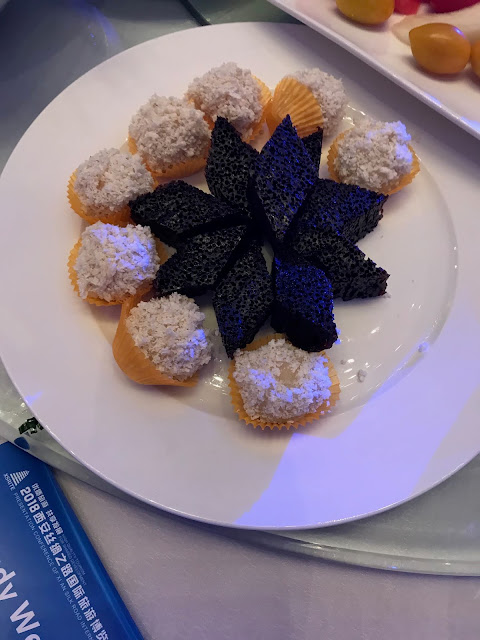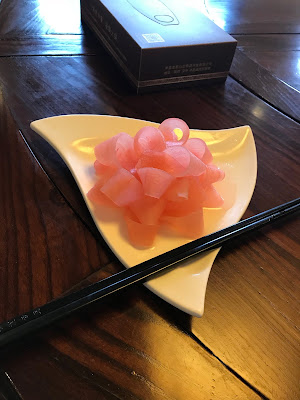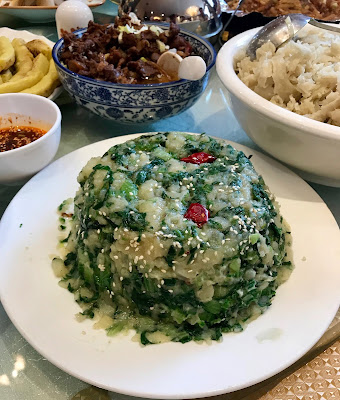China has as many different flavors as it has people. Shaanxi Province has more than its fair share and if we didn't taste them all we came very close.
Meals were served at tables centered with large lazy Susans that stayed full throughout the many courses. Each lunch and dinner was an extravaganza of dishes new to us. Even those that were not to our tastes were pleasing to the eye.
Our hosts ordered for us, the plan being to feature each area's specialty, but plans often went awry. After the initial banquet, menus were never available so rarely did we know what we were eating or the Chinese name by which we would order it. Only occasionally was it possible to find out any details of preparation or contents. Delicious, but very frustrating.
The first banquet in Xi'an, hosted by Shaanxi Tourism, introduced us to a variety of food but we were in no shape to appreciate it after 30 straight hours of travel followed immediately by four hours of touring and the elegant reception at the Crowne Plaza Xi'an. Fortunately it was the one time a menu was provided.
Here's what we had, but for the life of me I can't remember a bite of it:
Cold: Sauce with skin of donkey meat, vinegar jellyfish, brine with duck breast, beef tendons jelly, almond and mulberry sprouts, Shaanxi cold noodles, preserved plum and kidney bean, Chinese celery and bamboo shoots.
Followed by: Mushroom soup, sauteed shrimp with assorted vegetables, stir-fried mutton with vegetables and mushrooms, steamed Mandarin fish, deep-fried crispy chicken with spicy salt, black pepper short rib, stewed assorted vegetables with glass noodle, sliced pork belly, celery and lily fried Chinese yam, mushroom fried vegetables, fresh fruit platter, fried rice, hand-made noodles with assorted vegetable, Shaanxi rougamo.
 |
| And this is? |
We next were introduced to the wonder and variety of dumplings at De Fa Chang where more than 200 different kinds of dumplings have been served since 1935. We experienced 20 and their pickled bok choy leaves and cucumber were the perfect accompaniment.
A memorable banquet at Tang Dynasty Art Garden Hotel, headquarters of the Shaanxi Cuisine Research Institute, introduced us to a number of dishes relished by past emperors, among them a dish consisting of gourd bottom with dried scallops that tasted exactly like crab; a black moss,
a wild vegetable, with wheat flour that can only be eaten in April and May
and cherries with boiled, pulled chicken, head on, of course.
I particularly liked being able to try and compare three different types of noodles.
Would love to have sampled the fare in the Muslim quarter,
but it was stop and eat or keep going and try to capture the vibe of this people-watching paradise.
After zipping through the countryside on satin-smooth high speed rail, to Yangxian, we were gobsmacked when lunch was presented, an enormous, exquisite dish of shellfish - crabs, prawns, mussels and more.
Accompanying were local specialties and pristine curls of daikon, but the seafood starred.
In Hanzhong we had one of the most exquisitely plated array of dishes.
Tasted as good as it looked, too.
All Western-style hotels we encountered offered similar Asian- and Western-style breakfast buffets.
 |
| A typical breakfast - a touch of eggs, noodles, fruit, steamed buns and a whatsit? lets find out. |
The Wenyuan Pavilion Hotel in Hancheng was one of the sleekest and had the best sesame buns.
Basic, no fancy presentation just basic food like a hot broth and veggie soup, more vegetables, potatoes and bread piled on a table in Dang's village.

The best street food was in Hangchen in what was referred to as "gourmet" street. Unfortunately, after a long cold day rain was starting to fall and the Good Girls were dead tired. We saw what looked like barbecue in a taco, bought it and loved the flavorful lamb and soft wrap. Watch out though; it's juicy and will be down the front of you if you don't watch out.
After seeing the Yellow River and Hukou Waterfall, we were introduced to Sweet and sour Yellow River carp and some northern Shaanxi specialties. Luckily it was good enough that for the moment I disregarded the National Geographic article on Yellow River pollution.
We first encountered this dish in the Yulin area. Reluctant at first, we discovered it was a delicious combination of potatoes and greens.
When we read over our itinerary we were sure the term "hand-grabbed lamb" was a misinterpretation from Chinese to English. Imagine our surprise when it was served, roasted splayed lamb along with disposable plastic gloves and sharp knives. Cut into a section and grab a hunk of meat. Hand-grabbed lamb.
Yummy.
Stopping in a small town between Yulin and Yan-An, we enjoyed watching the street cooks and children.

It was the season for moon cakes and rather than the elaborately baked ones in cities,
these were very basic. Tasty but a bit dry.
The children went for ice cream which came with a variety of brightly colored cones.
When was the last time you had lunch in a greenhouse?
We did in Yan'an in Northern Shaanxi and it was a treat.
We passed rows of seedlings and more mature plants as we neared the greenhouse of this village-like collective. We were seated at chic tables between a stage on one end, plants at the other.
As the food was brought out we knew we were in for an exciting lunch.
Each dish was fresher than fresh with a variety of new offerings,
many of which we had yet to see or taste.
A number were on the spicy side
but the selections of breads dampered the effects.
We were entertained by two singing musicians who reminded me of a Chinese version of tale-telling country or folk duet. Wish I knew what story they were singing about.
Would like to have lingered and earned more about the food and experiences of the residents but again, there was more to be seen.
We had a real surprise at dinner that night. Our glass topped lazy Susans were "painted"
representing Yan'an,
the heart of memorials to Chairman Mao and his headquarters during his fight for China.
The food was beautifully presented, too.
Our farewell To Xi'an and China dinner was an elegant affair held at the gleaming Gran Melia Hotel.
Their floral displays set a sophisticated tone.
The food presented was just as appealing.
And, to western palates, Shaanxi's version of a hamburger, rougamo, a delectable soft, chewy bun filled with pork or mutton.
Just the thing to energizing our packing for the flights home in the morning.






























































